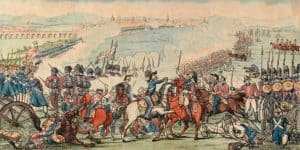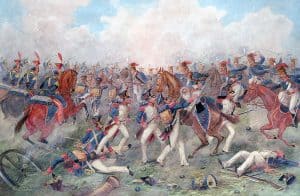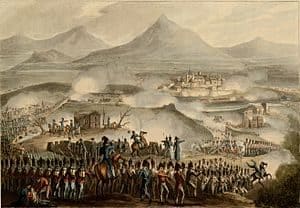The Peninsular War
To appease political pressure yet another ill-fated expedition was sent to the Low Countries in 1809 to destroy French shipping on the Scheldt. Known as the Walcheren expedition the plan failed and disease took many casualties.
In 1811 The King’s Own joined Wellington’s Army in the Peninsula, taking part in the campaign of the following year including many unremarkable skirmishes until the major battle at Salamanca.
Salamanca 22 July 1812

Battle of Salamanca 1812
Both The 3rd King’s Own Regiment of Dragoons and The 4th Queen’s Own Regiment of Dragoons fought with distinction at Salamanca.
They were two of the three Regiments that made up Le Marchant’s famous heavy Brigade that took part in a murderous Charge described by Wellington with praise, “I never saw anything so beautiful in all my life”.
Wellington’s perfect timing of his attack routed 40,000 Frenchmen in 40 minutes, with the cavalry being the chief instrument of destruction. The King’s Own had earned their second battle honour.
After wintering in Portugal, the British again had Wellington’s tactical mind to thank for pushing the French Army out of Spain with only a major decisive battle at Vittoria.
Vittoria 21 June 1813

The Battle of Vittoria 1813
The 3rd King’s Own Regiment of Dragoons and The 4th Queen’s Own Regiment of Dragoons fought together again as part of Ponsonby’s Heavy Brigade in this battle where the French decided to make a stand against Wellington’s armies.
Unfortunately, they were not called upon but were commended for maintaining their position and holding steady in the centre of the line.
After the French had broken, they were ordered to pursue; in so doing they had to ride through Vittoria itself were a lot of the allied army were busying themselves looting the baggage of the French.
At one stage the brigade rode along a track to the side of which lay a large mound of silver dollars – not one man stopped to help himself, and a Sergeant-Major was left behind to gather up the money which was then equally divided amongst the whole brigade.
After this battle, the French were finally pushed out of Spain and into France where the final battle in the Peninsular War was fought and won in 1814 at Toulouse.
Toulouse 10 April 1814

Battle of Toulouse 1814
The 3rd King’s Own Regiment of Dragoons and The 4th Queen’s Own Regiment of Dragoons fought together again as part of Ponsonby’s Heavy Brigade in this final battle of the Peninsular campaign.
They supported the Spanish infantry in the centre of the line and enabled them to reform after their initial assault had been repulsed, and then saved the Portuguese guns from being captured.
Only after the battle was won did the Allies learn that Napoleon had abdicated five days earlier.
The King’s Own chased the fugitive French Army, which had been beaten by the infantry.
In 1814 Napoleon had actually abdicated when Wellington fought and won the bloody encounter of Toulouse, The King’s Own final battle honour in addition to that of the whole campaign ‘Peninsula’.
Throughout the war, The 3rd had fought in the same brigade as The 4th, their future partners.
In all 210 men had been killed, and it must have been with relief that they reached home in July 1814.
Campaign Medal
 The Military General Service Medal 1793 – 1814 was authorised by a General Order dated 1st June 1847 and issued in 1848. This was a campaign medal for the issue to officers and men of the British Army, and sometimes it was referred to as the Peninsular Medal. It covers military actions from 1793-1814; a period encompassing the French Revolutionary Wars, the Napoleonic Wars, and the Anglo-American War of 1812.
The Military General Service Medal 1793 – 1814 was authorised by a General Order dated 1st June 1847 and issued in 1848. This was a campaign medal for the issue to officers and men of the British Army, and sometimes it was referred to as the Peninsular Medal. It covers military actions from 1793-1814; a period encompassing the French Revolutionary Wars, the Napoleonic Wars, and the Anglo-American War of 1812.
For each battle or action covered by the medal was represented by a clasp on the ribbon, with twenty-nine bars being awarded, fifteen being the most to any one recipient. The bars are fixed in multiples of three where applicable.
The bars mainly commemorate actions of the Peninsular War but also include various campaigns across the globe such as the West Indies, Egypt, and Java, the United States of America.
It is to be noted that the medal was only awarded to surviving claimants; one had both to have survived until 1847 and then to actively apply for it. A combination of factors, from general illiteracy to limited publicity for the new medal meant that many did not. There are substantially fewer medals issued compared with the number of men who served during this period.
The medal was awarded only to surviving claimants; next of kin could not apply for a medal on behalf of a deceased relative. However, the medal was awarded to the next of kin of those claimants who had died between the date of their application and the date of presentation.
Twenty Nine Bars Issued;
Egypt, Maida, Roleia, Vimiera, Sahagun, Benevente, Sahagun and Benevente, Corunna, Martinique, Talavera, Guadaloupe, Busaco, Barrosa, Fuentes D’Onor, Albuhera, Java, Ciudad Rodrigo, Badajoz, Salamanca, Fort Detroit, Chateauguay, Chrystler’s Farm, Vittoria, Pyrenees, St Sebastian, Nivelle, Nive, Orthes, Toulouse.

